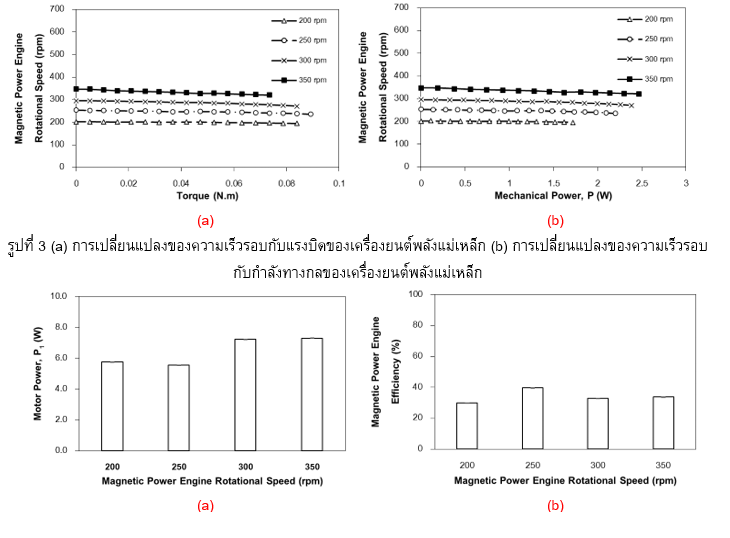MECHANICAL POWER AND PERFORMACE OF MAGNETIC POWER ENGINE
Main Article Content
Abstract
Designing and fabricating a magnetic power engine. Usually designed as a linear motion of the piston. Using magnetic repulsion as energy to push the piston head, effecting to the piston moving to power transmission to the crankshaft causing rotation. This research aim designed and fabricated a magnetic power engine and study the mechanical power and performance of a magnetic power engine. The rotor groove is 52 mm in diameter, 130 mm in diameter, and the shaft is 25 mm in diameter. One piston there are 4 magnetic attachments, grade N52, mounted around the rotor. This engine there are 2 pistons. The torque was tested with a brake dynamometer, torque values of 0.084 N·m, 0.089 N·m, 0.084 N·m and 0.074 N·m, and maximum mechanical power was 1.718 W, 2.198 W, 2.382 W and 2.469 W at 200 rpm, 250 rpm, 300 rpm and 350 rpm respectively. Magnet power engine can function as internal combustion engine, providing an alternative for the automotive industry of the future.
Article Details

This work is licensed under a Creative Commons Attribution-NonCommercial-NoDerivatives 4.0 International License.
เนื้อหาและข่อมูลในบทความที่ลงตีพิมพ์ในวารสารวิชาการ เทคโนโลยี พลังงาน และสิ่งแวดล้อม บัณฑิตวิทยาลัย วิทยาลัยเทคโนโลยีสยาม ถือเป็นข้อคิดเห็นและความรับผิดชอบของผู้เขียนบทความโดยตรง ซึ่งกองบรรณาธิการวารสารไม่จำเป็นต้องเห็นด้วย หรือว่าร่วมรับผิดชอบใด ๆ
บทความ ข้อมูล เนื้อหา รูปภาพ ฯลฯ ที่ได้รับการตีพิมพ์ในวารสารวิชาการ เทคโนโลยี พลังงาน และสิ่งแวดล้อม บัณฑิตวิทยาลัย วิทยาลัยเทคโนโลยีสยาม ถือเป็นลิขสิทธิ์ของวารสารวิชาการ เทคโนโลยี พลังงาน และสิ่งแวดล้อม บัณฑิตวิทยาลัย วิทยาลัยเทคโนโลยีสยาม หากบุคคล หรือหน่วยงานใดต้องการนำทั้งหมด หรือส่วนหนึ่งส่วนใดไปเผยแพร่ต่อ หรือเพื่อกระทำการใด ๆ จะต้องได้รับอนุญาต เป็นลายลักษณ์อักษรจากวารสารวิชาการ เทคโนโลยี พลังงาน และสิ่งแวดล้อม บัณฑิตวิทยาลัย วิทยาลัยเทคโนโลยีสยาม เท่านั้น
References
ดร.ธนาวดี ลี้จากภัย. (2565, สิงหาคม. 28). รถยนต์กับการเดินทางที่เพิ่งเริ่มต้น, แหล่งที่มา: https://www2.mtec.or.th/th/e-magazine/admin/upload/226_8-13-edit.pdf
M. Sudheer, K. Vasu and K. S. Vamsi, “Magnetic Piston Engine”, International Journal of Mechanical Engineering and Robotics, 3 (1), 2014, pp. 59-66.
T. Ahmad and D. Zhang, “A critical review of comparative global historical energy consumption and future demand: The story told so far”, Energy Reports, 6, 2020, pp. 1973-1991.
P. A. Owusu and S. Asumadu-Sarkodie, “A Review of Renewable Energy Sources, Sustainability Issues and Climate Change Mitigation”, Cogent Engineering, 3, 2016, pp. 1-14.
World Energy Resources, World Energy Council, 2016, pp. 6-46.
V. Bhaskar, R. H. Prakash and B. D. Prasad, “Hydrogen Fuelled IC Engine – An Overview”, International Journal of Innovative Technology and Research, 1 (1), 2013, pp. 46-53.
J. A. Sanguesa, V. Torres-Sanz, P. Garrido, F. J. Martinez and J. M. Marquez-Barja, “A Review on Electric Vehicles: Technologies and Challenges”, Smart Cities, 4, 2021, pp. 372-404.
H. Palacios. (2022, July. 20). Magnetic Repulsion Piston Engine (MRPE). [Online] Available: https://contest.techbriefs.com/2011/entries/sustainable-technologies/1378
ICELANDIC CO., LTD. (2022, August. 9). Permanent Magnet. [Online] Available: http://www.iclmagnet.com/products_list.php?type=Permanent%20Magnet
Ningbo Risheng Magnets Co., Ltd. (2022, August. 9). Grades of Neodymium Magnets. [Online] Available: https://www.rishengmagnets.com/products/neodymium-magnets?gclid=EAIaIQobChMIsZjmxriq-gIVypNmAh3OJAyZEAAYAiAAEgL78fD_BwE
P. Ganesh Bairavan and T. Anojan. “Design and Fabrication of Magnetic Engine”, International Journal of Research in Engineering and Technology, 6 (4), 2017, pp. 17-21.
K. Srirussamee, B. Hok and A. Phukaoluan. “Thermomechanical Performance of the Offset Crankshaft Heat Engine Driven by TiNiCu Shape Memory Alloys”, Engineering Journal, 25(2), 2021, pp. 85-93.


